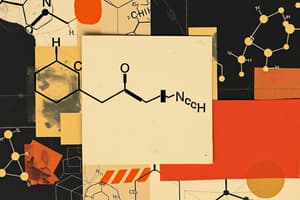Podcast
Questions and Answers
What characterizes alkenes in terms of their chemical structure?
What characterizes alkenes in terms of their chemical structure?
- They contain one or more carbon-carbon double bonds. (correct)
- They are derived from removing hydrogen from an alkane.
- They are saturated hydrocarbons.
- They contain only carbon-carbon single bonds.
Which of the following best describes cyclic hydrocarbons?
Which of the following best describes cyclic hydrocarbons?
- They are always saturated.
- They can only contain single bonds.
- They contain carbon atoms arranged in a ring. (correct)
- They are always aromatic structures.
What is the primary difference between constitutional isomers and stereoisomers?
What is the primary difference between constitutional isomers and stereoisomers?
- Stereoisomers have different molecular formulas.
- Constitutional isomers share the same connectivity of atoms.
- Stereoisomers must only differ in double bond placement.
- Constitutional isomers have the same molecular formula but different connectivity. (correct)
Which term refers to hydrocarbons that only contain carbon and hydrogen atoms?
Which term refers to hydrocarbons that only contain carbon and hydrogen atoms?
What does the prefix 'cis' indicate in cis-trans isomers?
What does the prefix 'cis' indicate in cis-trans isomers?
Which of the following statements is true regarding saturated hydrocarbons?
Which of the following statements is true regarding saturated hydrocarbons?
What is the main component of natural gas?
What is the main component of natural gas?
What does IUPAC stand for in chemical nomenclature?
What does IUPAC stand for in chemical nomenclature?
What distinguishes alkynes from alkenes in their structure?
What distinguishes alkynes from alkenes in their structure?
Which statement accurately describes a cycloalkane?
Which statement accurately describes a cycloalkane?
How do constitutional isomers differ from each other?
How do constitutional isomers differ from each other?
What term refers to the arrangement of atoms around a stereocenter?
What term refers to the arrangement of atoms around a stereocenter?
What is the primary characteristic of arenes?
What is the primary characteristic of arenes?
Which of the following best describes an alkyl group?
Which of the following best describes an alkyl group?
What is a saturated hydrocarbon?
What is a saturated hydrocarbon?
Which statement is true regarding the line-angle formula?
Which statement is true regarding the line-angle formula?
What type of hydrocarbon contains at least one carbon-carbon double bond?
What type of hydrocarbon contains at least one carbon-carbon double bond?
Which statement accurately describes constitutional isomers?
Which statement accurately describes constitutional isomers?
Which term describes hydrocarbons that contain one or more benzene-like rings?
Which term describes hydrocarbons that contain one or more benzene-like rings?
What defines a saturated hydrocarbon?
What defines a saturated hydrocarbon?
Which type of hydrocarbon is specifically categorized as containing carbon atoms bonded in a ring structure without double or triple bonds?
Which type of hydrocarbon is specifically categorized as containing carbon atoms bonded in a ring structure without double or triple bonds?
What is the significance of the prefix 'trans' in trans-isomers?
What is the significance of the prefix 'trans' in trans-isomers?
Which of the following is true regarding alkyl groups?
Which of the following is true regarding alkyl groups?
What is a common example of a saturated hydrocarbon?
What is a common example of a saturated hydrocarbon?
What distinguishes aliphatic hydrocarbons from other types of hydrocarbons?
What distinguishes aliphatic hydrocarbons from other types of hydrocarbons?
Which of the following compounds is an example of a cyclic hydrocarbon?
Which of the following compounds is an example of a cyclic hydrocarbon?
What does the term 'configuration' refer to in organic chemistry?
What does the term 'configuration' refer to in organic chemistry?
Which group is formed by removing a hydrogen atom from an alkane?
Which group is formed by removing a hydrogen atom from an alkane?
What is a characteristic of cis-trans isomers?
What is a characteristic of cis-trans isomers?
What type of bonds do saturated hydrocarbons contain?
What type of bonds do saturated hydrocarbons contain?
What role do benzene-like rings have in arenes?
What role do benzene-like rings have in arenes?
Which term refers to compounds with identical molecular formulas but differing connectivity of atoms?
Which term refers to compounds with identical molecular formulas but differing connectivity of atoms?
Flashcards
Alkane
Alkane
Saturated hydrocarbon with only carbon-carbon single bonds.
Alkene
Alkene
Unsaturated hydrocarbon with carbon-carbon double bonds.
Alkyne
Alkyne
Unsaturated hydrocarbon with carbon-carbon triple bonds.
Hydrocarbon
Hydrocarbon
Signup and view all the flashcards
Saturated Hydrocarbon
Saturated Hydrocarbon
Signup and view all the flashcards
Constitutional Isomer
Constitutional Isomer
Signup and view all the flashcards
Cis-trans Isomer
Cis-trans Isomer
Signup and view all the flashcards
IUPAC Nomenclature
IUPAC Nomenclature
Signup and view all the flashcards
Saturated Hydrocarbon
Saturated Hydrocarbon
Signup and view all the flashcards
Alkane
Alkane
Signup and view all the flashcards
Unsaturated Hydrocarbon
Unsaturated Hydrocarbon
Signup and view all the flashcards
Alkene
Alkene
Signup and view all the flashcards
Alkyl Group
Alkyl Group
Signup and view all the flashcards
Constitutional Isomers
Constitutional Isomers
Signup and view all the flashcards
Cis-trans Isomers
Cis-trans Isomers
Signup and view all the flashcards
IUPAC Nomenclature
IUPAC Nomenclature
Signup and view all the flashcards
Alkane
Alkane
Signup and view all the flashcards
Alkene
Alkene
Signup and view all the flashcards
Alkyl Group
Alkyl Group
Signup and view all the flashcards
Constitutional Isomer
Constitutional Isomer
Signup and view all the flashcards
Cis-trans Isomer
Cis-trans Isomer
Signup and view all the flashcards
IUPAC Nomenclature
IUPAC Nomenclature
Signup and view all the flashcards
Hydrocarbon
Hydrocarbon
Signup and view all the flashcards
Saturated Hydrocarbon
Saturated Hydrocarbon
Signup and view all the flashcards
Alkane
Alkane
Signup and view all the flashcards
Unsaturated hydrocarbon
Unsaturated hydrocarbon
Signup and view all the flashcards
Alkene
Alkene
Signup and view all the flashcards
Alkyl group
Alkyl group
Signup and view all the flashcards
Constitutional Isomer
Constitutional Isomer
Signup and view all the flashcards
Cis-trans Isomer
Cis-trans Isomer
Signup and view all the flashcards
IUPAC Nomenclature
IUPAC Nomenclature
Signup and view all the flashcards
Hydrocarbon
Hydrocarbon
Signup and view all the flashcards
Study Notes
Alkanes, Alkenes, Alkynes, and Arenes
- Alkanes: Saturated hydrocarbons with only single C-C bonds, ending in -ane
- Alkenes: Unsaturated hydrocarbons with at least one C=C double bond, ending in -ene
- Alkynes: Unsaturated hydrocarbons with at least one C≡C triple bond, ending in -yne
- Arenes: Unsaturated hydrocarbons containing benzene-like rings
Aliphatic Hydrocarbons
- Aliphatic hydrocarbons: Alkanes
Alkyl Group
- Alkyl group: Formed by removing a hydrogen atom from an alkane, symbolized as -R
Cis-trans Isomers
- Cis-trans isomers: Same connectivity, different spatial arrangement. "Cis" positions are on the same side, "trans" on opposite sides of a ring or double bond
Common Nomenclature
- Common Nomenclature: Older naming system, still widely used alongside IUPAC
Configuration
- Configuration: Arrangement of atoms around a stereocenter, describing spatial orientation
Constitutional Isomers
- Constitutional Isomers (Structural Isomers): Same molecular formula, different connectivity of atoms
Cyclic Hydrocarbons
- Cyclic Hydrocarbon: Contains carbon atoms forming a ring
Cycloalkane
- Cycloalkane: Saturated hydrocarbon with a ring structure
Hydrocarbons
- Hydrocarbon: Organic compound solely containing carbon and hydrogen atoms
IUPAC Nomenclature
- IUPAC Nomenclature: International standard for naming chemical compounds
Line-Angle Formula
- Line-Angle Formula: Simplified representation of structural formulas, each vertex and line terminus represents a carbon atom, and each line represents a bond
Methylene Group
- Methylene Group: -CH2-
Natural Gas
- Natural Gas: Primarily composed of methane (90-95%), ethane (5-10%), and other low-boiling alkanes
Oxidation of Alkanes/Combustion
- Combustion: Exothermic reaction of alkanes with oxygen to produce carbon dioxide, water and energy.
Propane
- Propane: Example of an alkane (CH3CH2CH3), used as a fuel source
Halogenation of Alkanes
- Halogenation: Reaction of an alkane with chlorine or bromine, substituting a halogen atom for a hydrogen atom
Petroleum
- Petroleum: Mixture of hydrocarbons
Saturated Hydrocarbon
- Saturated Hydrocarbon: Contains only single bonds
Stereocenter
- Stereocenter: Tetrahedral carbon atom, where the exchange of two groups results in stereoisomer
Stereoisomers
- Stereoisomers: Isomers with same connectivity but different spatial arrangements
Unsaturated Hydrocarbons
- Unsaturated Hydrocarbons: Possess one or more double, triple bonds or benzene-like rings.
Studying That Suits You
Use AI to generate personalized quizzes and flashcards to suit your learning preferences.




